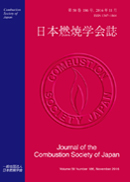65 巻, 211 号
選択された号の論文の8件中1~8を表示しています
- |<
- <
- 1
- >
- >|
特集 —進化する消火技術
-
原稿種別: 特集 —進化する消火技術
2023 年 65 巻 211 号 p. 9-16
発行日: 2023/02/15
公開日: 2023/04/18
PDF形式でダウンロード (18323K) -
原稿種別: 特集 —進化する消火技術
2023 年 65 巻 211 号 p. 17-23
発行日: 2023/02/15
公開日: 2023/04/18
PDF形式でダウンロード (6049K) -
原稿種別: 特集 —進化する消火技術
2023 年 65 巻 211 号 p. 24-28
発行日: 2023/02/15
公開日: 2023/04/18
PDF形式でダウンロード (7503K) -
原稿種別: 特集 —進化する消火技術
2023 年 65 巻 211 号 p. 29-36
発行日: 2023/02/15
公開日: 2023/04/18
PDF形式でダウンロード (5979K) -
原稿種別: 特集 —進化する消火技術
2023 年 65 巻 211 号 p. 37-40
発行日: 2023/02/15
公開日: 2023/04/18
PDF形式でダウンロード (2265K) -
原稿種別: 特集 —進化する消火技術
2023 年 65 巻 211 号 p. 41-48
発行日: 2023/02/15
公開日: 2023/04/18
PDF形式でダウンロード (10167K)
連載講座 —液体燃料の燃焼物理と化学 I
-
原稿種別: 連載講座 —液体燃料の燃焼物理と化学 I
2023 年 65 巻 211 号 p. 49-56
発行日: 2023/02/15
公開日: 2023/04/18
PDF形式でダウンロード (7694K) -
原稿種別: 連載講座 —液体燃料の燃焼物理と化学 I
2023 年 65 巻 211 号 p. 57-63
発行日: 2023/02/15
公開日: 2023/04/18
PDF形式でダウンロード (10143K)
- |<
- <
- 1
- >
- >|
